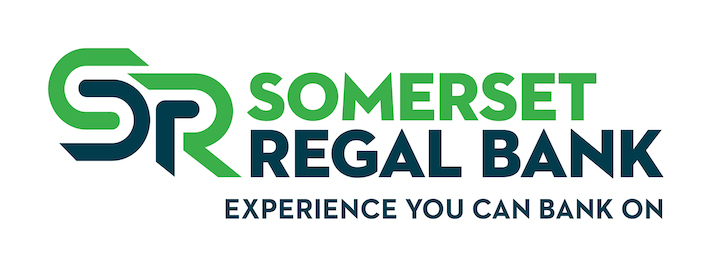Security
Safety
As a customer of Somerset Regal Bank, the security of your personal and account information is extremely important to us. By practicing good security habits, you can help us ensure that your private information is protected.
Online Security
Protecting Your Identity
Phishing
ATM Safety
Deepfake Media Scams
Cyber Security
Practicing Safe Checks
Online Security
Stop. Think. Click.
Several precautions can be taken to safeguard your computer and information during everyday use. Each time you connect to the Internet to exchange information you open a pathway from the outside world to your computer. The following tips can help reduce the risk of malicious content making its way into your computer.
Install anti-virus software.
Make sure that your computer has virus protection software that detects and removes all forms of viruses and spyware which can steal information. Be certain to use the software regularly and to keep it updated.
Ensure that your computer has a firewall.
A firewall is like a guard, watching for outside attempts to access your system and blocking communications to and from sources you don't permit. Many systems come with a built-in firewall. Make sure it's turned on. If your system does not have a firewall, purchase firewall software and install it.
Update operating systems and software.
Install all software fixes (sometimes called "patches" or "service packs") that are made available for your computer as soon as possible, especially if the fix addresses a security hole.
Practice safe computing.
Make sure that if you are sending personal information your connection is secure. A closed padlock appears on the status bar of secure web sites and the address will start with https:// rather than https://. Use passwords to protect access to your computer. Do not open email attachments if you do not know what is in the attachment or if you do not know who it came from. Do not reply to emails asking for sensitive personal or financial information. We would never ask for this type of information via an email or pop-up message.
Protecting Your Identity
Identity theft occurs when someone else uses your personal information to open a bank account, acquire a credit card or engage in other fraudulent acts.
You can minimize your risk of identity theft or account fraud.
- Keep items with personal information in a safe place. Destroy or shred them when you no longer need them.
- When outside your home, carry the minimum amount of personal information and credit cards that you need.
- Protect your PINs and passwords. Don't use birth dates, social security numbers or telephone numbers. Use a combination of letters and numbers if possible, and do not write PINs and passwords down — memorize them.
- Review your consumer credit report annually.
- Do not give out personal information over the telephone, through the mail, or over the Internet unless you have initiated the contact and know who you are dealing with.
- If a regular bill fails to reach you, call the company to find out why. Someone may have filed a false change-of-address form to divert your information to his/her address.
- Don't put outgoing mail in your mailbox. Drop it in a secure U.S. Postal Service collection box. Remove mail from your own mailbox promptly.
- Be careful about giving out personal information online. Practice safe computing.
What to do if you suspect account fraud.
- Don't panic! Contact the appropriate bank or creditor for any account that has been tampered with, or opened fraudulently, so that appropriate action can be taken.
- Contact the fraud department of each major credit bureau and request that a fraud alert and a victim's statement be placed in your file.
- Contact the Federal Trade Commission's Identity Theft Hotline at 877-ID-THEFT or www.consumer.gov/idtheft.
- File a report with your local police department and get a copy to submit to your creditors and others that may require proof of the crime.
- Remain vigilant over the next 12-24 months and promptly report incidents of suspected identity theft.
Phishing
In the computer world, phishing — it's pronounced "fishing" — is the act of seeking or fishing for information in a sly or indirect way. Phishers send seemingly legitimate emails warning of a serious problem that requires immediate attention and attempt to lure you to an imitation of a legitimate web site. If you provide the information requested, you may find yourself the victim of identity theft fraud.
Don't take the bait. Look before you bite.
- Never provide your personal information in response to an unsolicited request whether it is over the telephone or the Internet.
- If you believe the contact may be legitimate, contact the financial institution yourself. You should be the one to initiate the contact using information that you verified yourself.
- Never provide your password over the telephone or in response to an unsolicited Internet request.
- Review account statements regularly to ensure all charges are correct.
Resources
In the event you are a victim of identity theft, you may find the following telephone numbers and consumer links useful in locating information and providing guidance on how to file complaints:
Credit Reporting Bureaus:
Equifax (www.equifax.com)
Place a fraud alert: 888-766-0008
Order a credit report: 800-685-1111
Experian (www.experian.com)
Place a fraud alert: 888-397-3742
Order a credit report: 888-397-3742
TransUnion (www.transunion.com)
Place a fraud alert: 800-680-7289
Order a credit report: 800-888-4213
Federal Trade Commission (www.consumer.gov/idtheft):
You can file an identity theft complaint with the FTC online or by calling the FTC's Identity Theft Hotline at 877-438-4338.
Internet Fraud Complaint Center (www.ifccbi.gov):
The IFCC provides a convenient and easy-to-use online reporting mechanism that alerts authorities of a suspected criminal or civil violation.
ATM Safety
Playing it safe at the ATM.
Because we care about your safety, we offer these tips...
Treat your ATM card like cash.
Know where it is at all times and keep it secure. Guard it as carefully as you would cash, checks or a credit card.
Safeguard your Personal Identification Number (PIN).
Do not write it on your card or keep your card and any written record of your PIN in the same location. Memorize it instead. Do not allow another person to look over your shoulder as you enter your PIN at an ATM.
Choose an ATM carefully and use common sense.
Be aware of your surroundings, particularly at night. Avoid ATMs in dark or remote areas or where people seem to be loitering. Walk away if you notice something suspicious.
Withdraw cash safely.
Have your ATM card in your hand as you approach the ATM. When you collect your cash, immediately put it away, take your receipt and keep moving.
Promptly report anything suspicious.
Immediately report a lost or stolen card or if you notice something suspicious at an ATM. Also notify us immediately about an unauthorized ATM or debit card transaction on your account.
Deepfake Media Scams
Scams targeting Americans are surging.
Since 2020, the FBI has received 4.2 million+ reports of fraud. That’s $50.5 billion in losses.
Imposter scams in particular are on the rise in the age of artificial intelligence (AI). Criminals are using deepfakes, or media that is generated or manipulated by AI, to gain your trust and scam you out of your hard-earned money.
Deepfakes can be altered images, videos or audio. They may depict people you know — including friends and family — or public figures including celebrities, government officials and law enforcement.
How to detect a deepfake
Look for inconsistencies:
- Are any of the facial features blurry or distorted?
- Does the person blink too much or too little?
- Do the hair and teeth look real?
- Are the audio and video out of sync?
- Is the voice tone flat or unnatural?
- Does the visual show odd or unnatural shadows or lighting?
Tips to stay safe:
- STOP AND THINK. Is someone trying to scare you or pressure you into sending money or sharing personal information?
- VERIFY the legitimacy of people and requests by using trusted numbers, official websites and online reverse image/video search tools.
- CREATE CODEWORDS or phrases with loved ones to confirm identities.
- LIMIT YOUR DIGITAL FOOTPRINT. Photos, voice clips and videos can be used to train deepfake models.
- NEVER REPOST videos or images without verifying the source.
Red flags of a deepfake scam
- Unexpected requests for money, passwords, personal information or secrecy.
- Emotional manipulation involving fear or urgency.
- Uncharacteristic communication from someone you know, especially over text, phone or video.
Report scams
- To your local police
- To the FBI at IC3.gov
- To your bank if you sent money
Cyber Security
Every day, thousands of people fall victim to fraudulent emails, texts and calls from scammers pretending to be their bank, a loved one, the government or law enforcement. And in this time of expanded use of online and mobile banking, the problem is only growing. In fact, the Federal Trade Commission’s report on fraud estimates that American consumers lost a staggering $12.5 billion to scams and other fraud in 2024 — an increase of 25% over 2023!
Scams aren’t so scary when you know what to look for. These criminals are skilled at tricking you — convincing you to trust them, pay them and act fast. Here are some common tactics used by criminals for you to be aware of:
- They ask you to open a link.
- They ask to you to keep it a secret
- They send an attachment.
- They request personal info like PINs, passwords or Social Security numbers.
- They pressure you to log into, or send money with payment apps.
Scammers use fear and pressure to trick you into reacting fast. Never click on strange links, open unexpected attachments, or give away login info. If something feels off, it probably is.
For tips on how to keep criminals at bay visit BanksNeverAskThat.com.
Protect Yourself By Practicing Safe Checks
Use Permanent Gel Pens
Just like wearing a seatbelt when you fly, use permanent ink when you write a check to protect yourself.
Avoid Blank Spaces
Fill those overhead compartments before takeoff! Similarly, make sure you fill out every blank space on a check so criminals can’t fill them in instead.
Withhold Personal Information
The person in the middle seat doesn’t need to know your whole life story, just like you don’t need to add personal info to your checks.
Review Accounts
Monitor your account activity on your online banking platform as attentively as you await a safe arrival message from a loved one. Regular reviews ensure you quickly notice anything out of the ordinary.
Check Your Checks
Regularly review your paid checks on your online banking platform as thoroughly as airport staff check your boarding pass. Ensure the indorsement is correct and reflects the intended payee and amount to guard against fraud.
Use Digital Payment Options
If you're switching to digital boarding passes, why not switch to your bank's payment app or online bill pay for fast and secure payments?
Follow Up
Just as you confirm your flight details, make sure to follow up with payees to confirm they've received and deposited your check.
Mastered Check Safety? Now Make Sure They Land Safely!
Turn on notifications
Sign up for informed delivery at USPS.com. It sends you daily email notifications of incoming mail and packages.
Retrieve your mail promptly
Don't leave checks in your mailbox overnight or for any other long period of time.
Pause your delivery
If you're heading out of town, ask the post office to hold your mail until you return.
Head to USPS
Mail checks from your local post office instead of using a home mailbox or a blue street mailbox.
Suspect Fraud? Do This.
- Contact your bank immediately.
- Report the fraudulent check to your bank. They can help stop payment, freeze your account if necessary, and guide you on the next steps.
- File a police report.
- Contact your local police department to file a report. This creates an official record of the fraud, which is useful for investigations and claims.
- Review your accounts regularly.
- Monitor your bank and credit card statements closely for any unauthorized transactions. Report any suspicious activity immediately.
- Report suspicious activity immediately.
- If your check was stolen in the mail, report it to the United States Postal Inspection Service at uspis.gov/report or call 1-877-876-2455.
Learn more about securing your checks.











